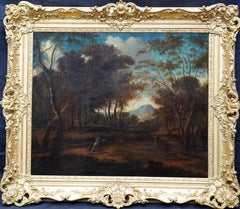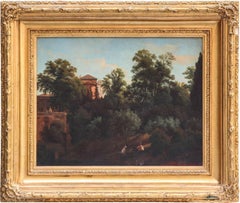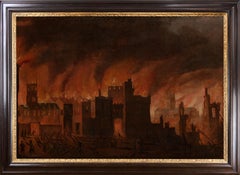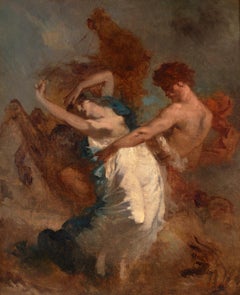Jean François Millet Paintings
to
1
1
1
1
Overall Height
to
Overall Width
to
1
1
6
914
658
658
610
1
1
Artist: Jean François Millet
Wooded Landscape with Diana Hunting - 17thC Old Master French art oil painting
By Jean François Millet
Located in London, GB
A original large French Old Master oil on canvas which is by Millet (1642-1679) and was painted circa 1675. This large canvas is in good clean condition and depicts a wooded landscap...
Category
17th Century Old Masters Jean François Millet Paintings
Materials
Oil
Related Items
19th Century Roman Landscape oil on canvas with Giltwood Frame
Located in Rome, IT
Amaizing 19' century Roman landscape depicting a part of Villa Borghese with Trinità dei Monti.
With a finely carved gilt wood coeval frame.
Measurements with frame cm 65 x78 wit...
Category
19th Century Old Masters Jean François Millet Paintings
Materials
Oil
Early oil depicting the Great Fire of London
Located in London, GB
The Great Fire of London in September 1666 was one of the greatest disasters in the city’s history. The City, with its wooden houses crowded together in narrow streets, was a natural fire risk, and predictions that London would burn down became a shocking reality. The fire began in a bakery in Pudding Lane, an area near the Thames teeming with warehouses and shops full of flammable materials, such as timber, oil, coal, pitch and turpentine. Inevitably the fire spread rapidly from this area into the City. Our painting depicts the impact of the fire on those who were caught in it and creates a very dramatic impression of what the fire was like. Closer inspection reveals a scene of chaos and panic with people running out of the gates. It shows Cripplegate in the north of the City, with St Giles without Cripplegate to its left, in flames (on the site of the present day Barbican). The painting probably represents the fire on the night of Tuesday 4 September, when four-fifths of the City was burning at once, including St Paul's Cathedral. Old St Paul’s can be seen to the right of the canvas, the medieval church with its thick stone walls, was considered a place of safety, but the building was covered in wooden scaffolding as it was in the midst of being restored by the then little known architect, Christopher Wren and caught fire. Our painting seems to depict a specific moment on the Tuesday night when the lead on St Paul’s caught fire and, as the diarist John Evelyn described: ‘the stones of Paul’s flew like grenades, the melting lead running down the streets in a stream and the very pavements glowing with the firey redness, so as no horse, nor man, was able to tread on them.’
Although the loss of life was minimal, some accounts record only sixteen perished, the magnitude of the property loss was shocking – some four hundred and thirty acres, about eighty per cent of the City proper was destroyed, including over thirteen thousand houses, eighty-nine churches, and fifty-two Guild Halls. Thousands were homeless and financially ruined. The Great Fire, and the subsequent fire of 1676, which destroyed over six hundred houses south of the Thames, changed the appearance of London forever. The one constructive outcome of the Great Fire was that the plague, which had devastated the population of London since 1665, diminished greatly, due to the mass death of the plague-carrying rats in the blaze.
The fire was widely reported in eyewitness accounts, newspapers, letters and diaries. Samuel Pepys recorded climbing the steeple of Barking Church from which he viewed the destroyed City: ‘the saddest sight of desolation that I ever saw.’ There was an official enquiry into the causes of the fire, petitions to the King and Lord Mayor to rebuild, new legislation and building Acts. Naturally, the fire became a dramatic and extremely popular subject for painters and engravers. A group of works relatively closely related to the present picture have been traditionally ascribed to Jan Griffier...
Category
17th Century Old Masters Jean François Millet Paintings
Materials
Canvas, Oil
View of Shipping on the River Avon from Durdham Down, near Bristol
Located in Stoke, Hampshire
Thomas Smith of Derby (c. 1710-1767)
View of Shipping on the River Avon from Durdham Down, near Bristol, 1756
Oil on canvas
Canvas size - 20 x 47 in
Framed size - 26 x 53 in
Provena...
Category
18th Century Old Masters Jean François Millet Paintings
Materials
Oil
IN THE WOOD - Italian landscape oil on board painting, Raffaele Tafuri
Located in Napoli, IT
IN THE WOOD - Italian oil on board framed painting, Italy, xx sec, Raffaele Tafuri.
External measurement cm.66x59
Raffaele Tafuri (1857-1929) was an I...
Category
Early 1900s Old Masters Jean François Millet Paintings
Materials
Oil, Board
Shepherd with Sheep, Cows and a Goat in a Landscape by Jan Frans Soolmaker
Located in Stockholm, SE
Jan Frans Soolmaker (Flanders 1635‑1685)
Shepherd with Sheep, Cows and a Goat in a Landscape
oil on relined canvas
canvas size 56 x 53 cm
frame i...
Category
17th Century Old Masters Jean François Millet Paintings
Materials
Oil, Canvas
Free Shipping
H 22.05 in W 20.87 in
Landscape With Pan and Syrinx, Flemish School From the 1600s, Oil on Copper
Located in Stockholm, SE
Flemish School, 1600s
Landscape With Pan and Syrinx
painted around the 1600s
oil on copper
19 x 23.5 cm
frame 29 x 34 cm
Hand-made oak frame by Swedish frame maker Christer Björkma...
Category
17th Century Old Masters Jean François Millet Paintings
Materials
Copper
H 11.42 in W 13.39 in
River Landscape with a Windmill and Chapel
By Jan Josefsz Van Goyen
Located in Palm Desert, CA
"River Landscape with a Windmill and Chapel" is a painting by Dutch Old Master Painter, Jan van Goyen. There are traces of a signature on the bow of the boat...
Category
1640s Old Masters Jean François Millet Paintings
Materials
Panel, Oil
Vedustist painter (Veneto school) - 19th century landscape painting - Padova
Located in Varmo, IT
Venetian painter (19th century) - Padua, Porta Liviana.
37.5 x 48.5 cm without frame, 50.5 x 60 cm with frame.
Oil on canvas, in a carved wooden frame.
Condition report: Good stat...
Category
Early 19th Century Old Masters Jean François Millet Paintings
Materials
Canvas, Oil
Free Shipping
H 19.89 in W 23.63 in
MARINE - Posillipo School - Italian Landscape Oil on Board Painting
By Enrico Capuano
Located in Napoli, IT
Marine - Enrico Capuano Italia 2009 - Oil on board cm. 20x33
Category
Early 2000s Old Masters Jean François Millet Paintings
Materials
Oil, Board
View of Ponte Milvio in Rome
Located in Roma, RM
Northern painter active in Rome in the second half of the 17th century, View of Ponte Milvio
Oil painting on canvas 73 x 97 cm in coeval Roman Salvator Rosa frame.
Category
18th Century and Earlier Old Masters Jean François Millet Paintings
Materials
Canvas, Oil
Allegory of Abundance
Located in New York, NY
Painted in collaboration with Hendrick van Balen (Antwerp, 1575 – 1632).
Provenance: Private Collection, Uruguay, since the 1930s.
The eldest son of Jan Br...
Category
17th Century Old Masters Jean François Millet Paintings
Materials
Copper
19th Century Oil Farmer And Bull Country Landscape Scene After Aelbert Cuyp
By Aelbert Cuyp
Located in York, GB
After Aelbert Cuyp (unsigned) an oil on board country scene depicting a farmer and bull. The painting is in overall very good condition however the frame has some losses .Mainly to...
Category
19th Century Old Masters Jean François Millet Paintings
Materials
Oil
Free Shipping
H 14.97 in W 18.12 in D 1.58 in
Previously Available Items
The Abduction of the Sabine Women
By Jean François Millet
Located in New Orleans, LA
This dynamic oil on canvas represents one of the most recognized subjects of art history by one of the most important artists of the 19th century. Entitled The Abduction of the Sabine Women, it was composed by the great Jean-François Millet, a painter who is rightfully celebrated as the master of the peasant. Rather than a sower or field laborer, however, this early work captures a mythological narrative, a remarkable rarity for this painter. The dramatic story lends Millet the opportunity to display his command of figure, gesture and tone, revealing the earliest hints of the Realist style that would come to define his artistic genius.
This tempestuous scene of a woman being abducted by a man on horseback was composed at a critical point in Millet’s career. After studying at the École des Beaux-Arts under the tutelage of the history painter Paul Delaroche, Millet achieved modest success as a portrait and genre painter. Yet, by the 1840s, he sought to establish himself on a larger stage and began working on classical and historical compositions for the Paris Salon with emphasis on the human figure. The Abduction of the Sabine Women is among his finest compositions during this important period.
The narrative refers to an incident in Roman mythology when Roman men abducted women from a neighboring region — known as the Sabines — to take as wives. Under the direction of their founder Romulus, the Romans sought to form peaceful alliances with their neighbors and formally requested the rights of marriage with neighboring tribes. Rome's emissaries, however, were unsuccessful, so Romulus decided upon more drastic measures in order to ensure the security and future of his city. According to Levy, during the festival of Neptune Equester, the Romans successfully fought off the Sabine men and captured the young Sabine virgins, who they then married. Though the action initially resulted in war between the two nations, eventually peace was won thanks to the intervention of the Sabine women, who begged for unity between their families and their new husbands.
Throughout art history, The Abduction of the Sabine Women has been depicted by modern and old masters from Giambologna’s 16th-century marble sculpture to masterpieces in oil by Nicolas Poussin, Peter Paul Rubens, Jacques-Louis David and Pablo Picasso. Millet's treatment of the subject reveals his own influences, most specifically the great French Romantic painter Eugène Delacroix.
Although the subject pays homage to Jacques-Louis David’s Neoclassicism, Millet’s use of broad, quick brushstrokes and strong color notes of deep blue-greens and oranges displays a Romantic treatment. In assessing this painting, Millet expert Alexandra Murphy writes, “Only a few documented works survive from this period, and [the] painting is important as a reminder that Millet was looking to the example of Delacroix’s work even more than to his own master, Delaroche.”
Within a few years of creating the work, Millet turned to realistic subjects and moved to Barbizon, where he lived for the rest of his life. By the 1870s, the artist’s work was well established in Boston collections, but it wasn’t until the 1880s that Millet’s popularity spread to other parts of the country. In 1886, two important painting auctions took place in New York at the American Art Galleries: the sale of the Estate of Mrs. Charles Morgan...
Category
19th Century Realist Jean François Millet Paintings
Materials
Canvas, Oil
Jean François Millet paintings for sale on 1stDibs.
Find a wide variety of authentic Jean François Millet paintings available for sale on 1stDibs. You can also browse by medium to find art by Jean François Millet in oil paint, paint and more. Much of the original work by this artist or collective was created during the 18th century and earlier and is mostly associated with the Old Masters style. Not every interior allows for large Jean François Millet paintings, so small editions measuring 40 inches across are available. Customers who are interested in this artist might also find the work of Sir Godfrey Kneller, Studio of Sir Peter Lely, and Goyo Dominguez. Jean François Millet paintings prices can differ depending upon medium, time period and other attributes. On 1stDibs, the price for these items starts at $15,290 and tops out at $15,290, while the average work can sell for $15,290.



